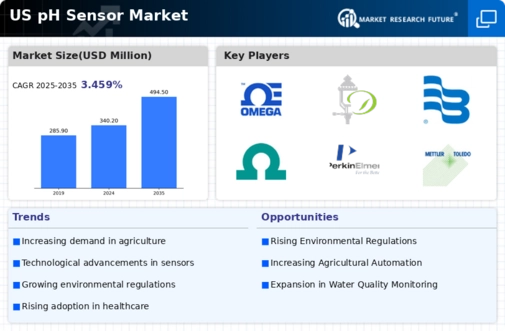The US pH Sensor Market is characterized by a dynamic competitive environment, where several key players offer a range of products suited to various industrial applications. With a growing emphasis on industrial automation and process control, the demand for pH sensors has been steadily increasing across sectors such as water treatment, pharmaceuticals, and food and beverage industries. Companies operating in this market focus on innovation to develop highly accurate and reliable sensors, which are essential for maintaining product quality and compliance with regulatory standards.
The competitive landscape is marked by continuous technological advancements, partnerships, and strategic collaborations aimed at enhancing market share and product offerings. Furthermore, market players are working on improving the durability and cost-effectiveness of pH sensors to cater to diverse customer needs. OMEGA Engineering stands out in the US pH Sensor Market due to its strong commitment to quality and innovation. The company has established a significant presence through a diverse portfolio of pH sensors and related instruments designed for various applications in industries such as chemical, food processing, and environmental monitoring.
OMEGA Engineering's strengths lie in its comprehensive customer service and extensive technical support, which differentiate it from competitors. The company’s robust distribution network facilitates the effective delivery of its products across different regions within the US, ensuring that customers have access to high-quality pH measurement solutions. Moreover, OMEGA focuses on incorporating the latest technological advancements into its product development processes, which helps maintain its position as a trusted brand in the industry. Endress+Hauser has carved out a notable space in the US pH Sensor Market, driven by its reputation for producing high-quality measurement technologies and automation solutions.
The company offers a wide array of products, including advanced pH sensors that are widely used in sectors such as water and wastewater management, food and beverage, and chemical processing. Endress+Hauser's strengths include their commitment to research and development, which enables them to continually innovate and improve product performance. The company has a solid market presence with a multi-faceted approach, including strategic partnerships and acquisitions that enhance their technological capabilities and market reach. Additionally, Endress+Hauser provides comprehensive services that extend beyond product sales, including engineering support and maintenance solutions, ensuring that their customers receive end-to-end assistance.
Through these strategies, Endress+Hauser continues to thrive within the competitive landscape of the US pH Sensor Market.






















